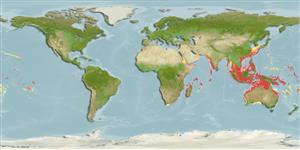Common names from other countries
Environment: milieu / climate zone / depth range / distribution range
Ecología
marino; salobre demersal; rango de profundidad 10 - 110 m (Ref. 12260). Tropical; 26°C - 29°C; 35°N - 36°S, 19°E - 137°W
Indo-Pacific: Red Sea and the east African coast (30° to about 50°S) to Australia and Tahiti, north to the Ryukyu Islands (Ref. 27956).
Tamaño / Peso / Age
Maturity: Lm ? range ? - ? cm
Max length : 21.0 cm FL macho / no sexado; (Ref. 5525); common length : 15.0 cm TL macho / no sexado; (Ref. 5450)
Espinas dorsales (total) : 8; Radios blandos dorsales (total) : 15 - 17; Espinas anales: 3; Radios blandos anales: 13 - 14.
Found in shallow inshore coastal waters over silty bottoms (Ref. 30573, 90102). Young enters mangrove estuaries or silty reef areas (Ref. 4833, 90102). Searches for prey using a protruding pipette-like mouth or by sieving potential food through their gill rakers (Ref. 26569). Feeds on small fishes, shrimps, other crustaceans, and polychaetes. Sold fresh and dried salted; also made into fishmeal.
Life cycle and mating behavior
Maturities | Reproducción | Spawnings | Egg(s) | Fecundities | Larva
James, P.S.B.R., 1984. Leiognathidae. In W. Fischer and G. Bianchi (eds.) FAO species identification sheets for fishery purposes. Western Indian Ocean (Fishing Area 51). Vol. 2. FAO, Rome. pag. var. (Ref. 3424)
IUCN Red List Status (Ref. 130435)
CITES (Ref. 128078)
Not Evaluated
Threat to humans
Harmless
Human uses
Pesquerías: comercial
Herramientas
Special reports
Download XML
Fuentes de Internet
Estimates based on models
Preferred temperature (Ref.
115969): 24.5 - 29, mean 27.9 (based on 1548 cells).
Phylogenetic diversity index (Ref.
82804): PD
50 = 0.5312 [Uniqueness, from 0.5 = low to 2.0 = high].
Bayesian length-weight: a=0.01549 (0.01184 - 0.02026), b=3.05 (2.98 - 3.12), in cm Total Length, based on LWR estimates for this species (Ref.
93245).
Nivel trófico (Ref.
69278): 4.2 ±0.0 se; based on diet studies.
Resiliencia (Ref.
120179): Alto, población duplicada en un tiempo mínimo inferior a 15 meses (K=0.70-1.30).
Fishing Vulnerability (Ref.
59153): Low vulnerability (14 of 100).
